
Silk Road Trade & Travel Encyclopedia
丝绸之路网站(丝路网站)
丝绸之路百科全书—游客、学生和教师的参考资源
İPEK YOLU ve YOLLARI ANSİKLOPEDİSİ
www.ipekyollari.net

Silk Road Trade & Travel Encyclopedia
丝绸之路网站(丝路网站)
丝绸之路百科全书—游客、学生和教师的参考资源
İPEK YOLU
ve YOLLARI
ANSİKLOPEDİSİ
www.ipekyollari.net
T
A B
C
D
E
F
G
H I
J
K
L
M
N O P
Q
R
S
T
U V
W
X
Y
Z
Tacheng (or Qoqek) in northwestern Xinjiang is an ancient city and once served as an important commercial town on the ancient Silk Road. It is a county-level city and the capital of Tacheng Prefecture, in northern Ili Kazakh Autonomous Prefecture, Xinjiang, China. Sometimes called Tarbaghatay or Tarbagatai (local Turkic speakers know it as Chöchek, Chawchak or Chuguchak) the city is located in the Dzungarian basin, some 10 km from the Kazakhstan border. It is a major center for trade with Central Asia. Attractions include the Badanxing Nature Reserve, Sarkule Lake, and Baketu Port.
Tafur
Pero Tafur A native and notable of Cordoba, born ca. 1410, Tafur
traveled from Spain to the Eastern Mediterranean and back. While not a merchant,
he was very interested in commercial affairs and well connected with the trading
networks. He travelled in Egypt, the Black Sea region, and Constantinople.
Taklamakan (Taklimakan) is a desert in Central Asia, in the Xinjiang Uyghur Autonomous Region of the People's Republic of China (west of the Gobi Desert). It is the world's 17th largest desert. It is bounded by the Kunlun Mountains to the south, and the Pamir Mountains and Tian Shan (ancient Mount Imeon) to the west and north. There is very little water in this desert region, and it is hazardous to cross. Merchant caravans on the Silk Road would stop for relief at the thriving oasis towns. Mummies, some perhaps 4000 years old, have been found in the region. More...

Talas River In 751 the Abbasid Caliphate defeated the Tang Dynasty in the Battle of Talas in Central Asia. During the Battle of Talas (named after the river) the combined Arab and Turkic forces defeated the invading Tang Chinese blocking the westward expansion of the Tang Dynasty. More...
Talgar In the 9th century a fortification belonging to the head of a Turkic tribe was founded on the place of Talgar settlement. The location was chosen because it was on the Silk Road at the foothills of Zailiisky Alatau, incorporating rich land resources and summer pastures. With time Talgar settlement became popular with merchants and craftsmen. Pik Talgar is a northern peak in the Tian Shan mountain range in Kazakhstan, named after the Talgar river and city. It is the highest peak of the Trans-Ili Alatau.
Tamerlane (See Timur)
Tana This ancient city in the northeast corner of the Black Sea marked the western end of a major trade route extending all the way across Asia to China.
Tang Dynasty (618-907 CE) The height of the importance of the Silk Road was during the Tang Dynasty in China, known as "a golden age of cosmopolitan culture." During this period of the Pax Sinica, the Silk Road reached its golden age, whereby Persian and Sogdian merchants benefited from the commerce between East and West. At the same time, the Chinese empire was host to many foreign cultures in its urban centers. The period of the Tang Dynasty is known for innovations. It was also at this time that religion was able to spread rapidly and freely along the Silk Routes. Despite the death of Mohammed in 632 AD, Islam was spreading rapidly as were other religions. There is a great deal of evidence that pilgrims and missionaries were present in Chang'an (near modern day Xi’an), the capital of the dynasty as well as the starting point of the Silk Road. At the the time, Europe was still in the Dark Ages not knowing in the future it would be indebted to the traders and empires of the Silk Routes, who preserved ancient knowledge that was passed on to the West.
Although the Silk Road from China to the West was initially formulated during the reign of Emperor Wu of Han (141-87 BC), it was revived by the Tang Dynasty in 639 when Hou Junji (d. 643) conquered western regions, and remained open for almost four decades. It was closed after the Tibetans captured it in 678, but in 699, during Empress Wu's period, the Silk Road reopened when the Tang reconquered the Four Garrisons of Anxi originally installed in 640, once again connecting China directly to the West for land-based trade. In 692, with the last defeat of the Tibetans (and a brief seizure of Kucha by Turgesh in 709) the Four Garrisons were permanently controlled by the Chinese thereafter. The Tang captured the vital route through the Gilgit Valley from Tibet in 722, lost it to the Tibetans in 737, and regained it under the command of the Goguryeo-Korean General Gao Xianzhi. After the An Shi Rebellion ended in 763, the Tang Empire had once again lost control over many of its outer western lands, as the Tibetans largely cut off China's direct access to the Silk Road. An internal rebellion in 848 ousted the Tibetan rulers, while Tang China regained its western territories from Tibet in 851. (See Bayanchur Khan) More...
During the Tang Dynasty there was great contact with, and interest, in India as a source for Buddhist knowledge. The well-known traveler Xuanzang (d. 664), after a 17-year long trip, brought back to China valuable Sanskrit texts to be translated into Chinese. More... Islam during the Tang Dynasty was spreading rapidly as were other religions. More...
The Tang capital of Chang'an became a great international metropolis, with traders and embassies from Central Asia, Arabia, Persia, Korea, and Japan using the Silk Routes. A Nestorian Christian community also existed there, while mosques were established in Guangzhou (Canton). Buddhism enjoyed great favour, and there were new translations of the Buddhist scriptures. Poetry was the greatest glory of the period; nearly 50,000 works by 2,000 poets survive. Foreign music and dance became popular, and ancient orchestras were revived. The economy flourished in the 8th – 9th centuries, with a network of rural market towns growing up to join the metropolitan markets of Chang'an and Luoyang.
Chinese envoys had been sailing through the Indian Ocean to India since perhaps the 2nd century BC, yet it was during the Tang Dynasty that a strong Chinese maritime presence could be found in the Persian Gulf and Red Sea, into Persia, Mesopotamia (sailing up the Euphrates River in modern-day Iraq), Arabia, Egypt, Aksum (Ethiopia), and Somalia in the Horn of Africa. From the same Quraysh tribe of Muhammad, Sa'd ibn Abi-Waqqas sailed from Ethiopia to China during the reign of Emperor Gaozu. He later traveled back to China with a copy of the Quran, establishing China's first mosque, the Mosque of Remembrance, during the reign of Emperor Gaozong. To this day he is still buried in a Muslim cemetery at Guangzhou.
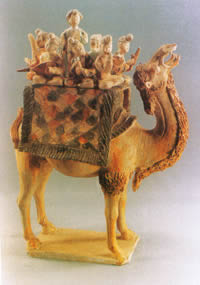
A Tang Dynasty ceramic camel that carries a small musical band with a female performer at the Shaanxi Museum.
During the Tang Dynasty, thousands of foreigners came and lived in numerous Chinese cities for trade and commercial ties with China, including Persians, Arabs, Indians, Malays, Sinhalese, Khmers, Chams, Jews, and Nestorian Christians of the Near East.
Tangut Empire (Western Xia) existed from 1038 to 1227 AD in what are now the northwestern Chinese provinces of Ningxia, Gansu, eastern Qinghai, northern Shaanxi, northeastern Xinjiang, southwest Inner Mongolia, and southernmost Outer Mongolia. It suffered from devastating destruction by the Mongols who founded the Yuan Dynasty (1271–1368). The state occupied the area of important trade route between North China, Central Asia, and the Hexi Corridor. It made significant achievements in literature, art, music, and architecture. More...
Tantras The name for the scriptures of the Vajrayana (a method of Buddhist practice).
Taoism (or Daoism) refers to a variety of related philosophical and religious traditions that have influenced Eastern Asia for more than two millennia. More...
Tarim Basin is located in the Xinjiang Uyghur Autonomous Region in China's far west. Its northern boundary is the Tian Shan mountain range, and its southern range is the Kunlun Mountains on the northern edge of the Tibetan Plateau. The Taklamakan Desert dominates much of the basin. The area is sparsely settled by the Uyghurs and other Turkic peoples.
The caravan routes of the Silk Road would split into two paths, the North Silk Road, passing along the northern edge, and the path going along the southern edge, of the Taklamakan Desert. A middle path was deserted in the sixth century. The southern path includes the oases of Yarkand, Niya, Pishan, Marin and Khotan. The key oases along the northern route are Aksu, Korla, Turpan, Gaochang and Loulan. Other key towns include Kashgar in the southwest, Kuqa in the north, and Dunhuang in the east.
Some of the most well-known mummies in the world are "The Tarim Basin mummies." They represent a span of history dating from 1800 BC to as recently as the Ching Dynasty (1644-1912). See Mummies. More...
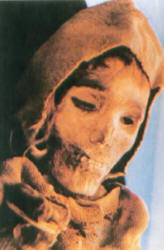
A mummy from the
Xinjiang Museum in Urumchi.
Tartar Tartar tribes near borders of China found several of their own dynasties (907 - 1227). More...
Tashkurgan The name Tashkurgan, which means “stone tower,” refers to the structure thought to have marked the midway point between Europe and China. According to legend, this tower is also the site of the world’s first silk trade, bartered in dumb show between merchants from the East and the West–a theory that is highly disputed, as the region boasts numerous unmarked stone towers.
Tashkent The capital of Uzbekistan and a major trading point on the historic Silk Road.

The Ancient Settlement of Minguruk Tashkent
Tavernier
Jean Baptiste Tavernier (1629-1675) French merchant/jeweler, who may have known the overland trade routes through Persia better than any other European in
the seventeenth century. His six voyages took him to the Ottoman Empire, Safavid
Persia, and Mughal India. His interactions with the merchant communities (notably
the Armenians in Persia) gave him an insider's perspective. His account reflects
the editing of a professional writer, but is precise and detailed.
Tax Merchants carrying goods along the silk, spice and incense routes not only had to plan for travel and transportation costs, but also had to be prepared to pay taxes, and money for protection of their goods against bandits. Regional authorities made a profit as they levied taxes (imposed and collected by legal authority) on foreign traders passing through their regions. The revenue (money) from taxes was so great that wars were fought in order to control the lucrative and profitable trade along different sections of the trade routes. Not only were wars fought, but cities also suffered the consequences if taxes were not collected (such as the city of Balkh in northern Afghanistan, which was destroyed by the Mongols after a rebellion).
Taxkorgan (Puli, or Jiepantuo) The Taxkorgan Valley, amidst huge mountain ranges, is by the border of China and Pakistan. There is a large fortress where Marco Polo and other travelers have passed along thier journeys. Taxkorgan is on the ancient Silk Road from where China's ancient civilizations went out to the west, and from where western civilizations came to China. The name Taxkorgan means "Stone Castle" in Uyghur.
Taxila is a city in the Punjab province of Pakistan, just off the Grand Trunk Road. It is one of the most important archaeological sites in Asia, situated strategically on a branch of the Silk Road that linked China to the West, the city flourished both economically and culturally. Taxila reached its apogee between the 1st and 5th centuries AD. Historically, this city lay at the crossroads of three major trade routes: 1) The northern road—later Grand Trunk Road—the royal road which connected Gandhara in the west to the kingdom of Magadha and its capital in the valley of the Ganges in the east. 2) The northwestern route through Bactria. 3) The Sindu (Indus river) route from Kashmir and Central Asia, via Sri nagara, Mansehra, and the Haripur valley across the Khunjerab pass to the Silk Road in the north to the Indian Ocean in the south. The Khunjerab passes between Kashmir and Xinjiang China—the current Karakoram highway—and was traversed in antiquity. In 1980, Taxila was declared a UNESCO World Heritage Site with multiple locations. It has been ranked as the top tourist destination in Pakistan. More... UNESCO
Te
Ch'ang Te (1259-1260) Envoy from Mongol Khan Möngke to his brother Hülegü soon after the
latter's conquest of the Abbasid Chaliphate. Ch'ang Te's Si Shi Ki,
recorded by Liu Yu, is part travel diary and part a second-hand account of
Hülegü's campaigns in the West.
Tea plants are native to East and South Asia and probably originated around the point of confluence of the lands of northeast India, north Burma, southwest China, and Tibet. The usage of tea as a beverage is first recorded in the Chinese classics Shennong Ben Cao Jing. It was already a common drink during Qin Dynasty (around 200 BC) and became widely popular during Tang Dynasty, when it was spread to Korea and Japan. Chinese tea ceremonies, offerings, culture and customs spread in China for thousands of years. The export and trade of tea by the Chinese during the 19th century, spread tea to Western nations and numerous locations around the world. More...
Tehran (Rey) Once famous for its palaces, its lusterware, and its secrecy: In A.D. 67, Parthians resolutely misled a Chinese envoy, telling him that the journey to Roman Syria would take more than two years and that most people died of homesickness on the way. He turned back, ensuring that the overland Silk Road trade remained in Persian hands. Rey was also damaged by the Mongol warriors, in 1221.
Temple A temple (from the Latin word templum) is a structure reserved for religious or spiritual activities. More...
Temujin (or Timucin, See Genghiz Khan)
Tenggeli Desert is mostly located within the boundary of Zhaogetuhuresumu of Alashan County (together with Moon Lake - Tenggeli Dalai) is in the Inner Mongolia Autonomous Region of China.. The Tenggeli Desert is China's fourth largest desert. Chinese geographers divide the region into three smaller deserts, the Tengger (Tengri) Desert in the south, the Badain Jaran (Baden Dzareng, or Batan Tsalang) in the west, and the Ulan Buh (Wulanbuhe) in the northeast.
Tengriism (or Tengrianism) is a religion that incorporates elements of shamanism, animism, totemism and ancestor worship. It was the major belief of the Xiongnu, Mongols, Turkic peoples, Hungarian and Bulgar peoples in ancient times. It focuses around the sky deity Tengri (also Tangri, Tanrı, Tangra) and reverence for the sky in general. Today, there are still a large number of Tengriist people living in Northern and Central Asia, such as the Khakas and Tuvans. "Khökh" and "Tenger" literally mean "blue" and "sky" in Mongolian. Many Mongolians today still pray to "Mönkh Khökh Tengri" ("Eternal Blue Sky"). Therefore Mongolia is called the "Land of Eternal Blue Sky" ("Mönkh Khökh Tengriin Oron" in Mongolian).
Terra Cotta Army (Terra Cotta horses and armored warriors) is part of an elaborate mausoleum created to protect and accompany the first Emperor of China into the afterlife. The life-size warriors and horses form a collection of terracotta sculptures depicting the armies of Qin Shi Huang, the first Emperor of China. The figures, dating from 210 BC, were discovered in 1974 by local farmers near Xi'an, Shaanxi province, China near the tomb of Emperor Qin. Patches of paint hint at once brightly colored clothes. Further excavations have revealed swords, arrow tips, and other weapons, many in pristine condition.
Terra cotta warriors and horses at the tomb of China's first Emperor Qin
Tianchi Lake (See Heavenly Lake)
Tianshan Mountains (Tian Shan, Heavenly Mountains) (Chinese: 天山 "celestial mountains"; Uygur: تەڭرىتاغ, Tengri Tagh); Turkish: Tanrı Dağları (Tien-Şan); is a mountain range located in Central Asia. The Chinese name for Tian Shan or Tien Shan, may in turn go back to a Xiongnu name, qilian (祁连) reported by the Shiji as the homeland of the Yuezhi. A nearby mountain range, the Tannu-Ola Mountains (Tuvan: Таңды-Уула Tangdy-Uula), also bears a synonymous name ("heavenly/celestial mountains" or "god/spirit mountains").
The mountain range lies to the north and west of the Taklamakan Desert in the border region of Kazakhstan, Kyrgyzstan and the Xinjiang Uyghur Autonomous Region of western China. In the south it links up with the Pamir Mountains. It also extends into the Chinese province of Xinjiang and into the northern areas of Pakistan, where it joins the Hindu Kush.
Tianshui was a hub of the Silk Road that now includes many places of interest, such as holy sites of the Silk Road, the Maijishan Grottoes, Fuxi Temple, and Yuquan Taoist Temple in east Gansu, China.
Tibet The Tibet Autonomous Region of the People's Republic of China is located in the southwest part of the Qinghai-Tibet Plateau (a vast, elevated plateau in Central Asia covering most of the Tibet Autonomous Region and Qinghai Province, in addition to smaller portions of western Sichuan, southwestern Gansu, and northern Yunnan in China). The Chinese provinces of Xinjiang, Qinghai and Sichuan lie to the north, northeast, and east, respectively. On the southeast is Yunnan province. The Tibet Autonomous Region shares borders with Kashmir to the west, and to the South with Nepal, Myanmar, Bhutan, India and Sikkim (which in 1975 became a state of the Indian Union however was not recognized by China). The Tibet Autonomous Region accounts for one eighth of China's total land mass, and is the second-largest province-level division of China by area after the Xinjiang Uyghur Autonomous Region. The region has various complex landforms such as high and steep mountains, deep valleys, glaciers, and deserts. The region lies at an average altitude of more than 4,000 meters. Mount Everest is located on Tibet's border with Nepal (the world's tallest peak). It is roughly divided into four areas: the north Tibet plateau, the south Tibet valley, east Tibet mountains and valleys, and Himalaya Mountains.
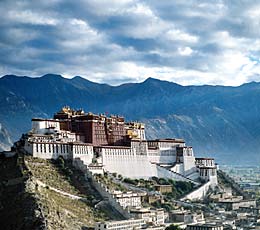
Potala Palace in the capital city of Lhasa
It has been over 700 years since Tibet was officially incorporated into China's territory during the Yuan Dynasty (1271-1368), founded by Kublai (Khubilai) Khan. In 1215, the year Kublai was born, the Mongols made their first major incursion into North China and initiated a period of extraordinary creativity in the arts that was encouraged by the confluence of many cultures and ethnic groups. This period lasted approximately 150 years and had its greatest flowering in the Yuan Dynasty.
In the early 13th century after Genghis Khan established the Mongol Khanate and conquered Western Xia and the "Western Regions," his grandson Godan Khan began to march into Central Asia. Godan Khan's base camp was stationed in Liangzhou, present-day Wuwei in northwestern China's Gansu Province. When China was ruled by the Mongols, the Sakya school governed Tibet as a tributary to the Mongols. After the death of Kublai Khan in 1295, the power of the Mongols in Central Asia began to wane, and by the second half of the fourteenth century, they had lost power over China, as well as Tibet.
After Kublai Khan established the Yuan Dynasty, the Central Government of the Yuan Dynasty set up the Xuanzheng Administration to handle religious and ethnic affairs in Tibet. Later the Central Government conferred on the Sakya sect the right of governance in Tibet. Tibet, instead of being a province, was directly governed by the Xuanzheng Administration of the Central Government with 13 wanhu (administrative divisions). Government officials above the wanhu level were designated by the emperor himself, while other Tibetan officials under the wanhu level were recommended by the leader of the Sakya sect for approval of the emperor. The Central Government of the Yuan Dynasty exercised all-round administration over Tibet, such as sending Mongolian troops to Tibet, three checks on the registered permanent residence, encouraging the implementation of the laws and regulations of the central government, establishment of a tax system and 17 daks linked to inland areas. Since the Central Government of the Yuan Dynasty governed Tibet via the administration of the Sakya sect, the Sakya Monastery was well maintained. Featuring the architectural characteristics of the Yuan Dynasty, the monastery has more Tibetan historical records and Buddhist scriptures than other monasteries.
Scholars have described this period of art and history as one where new art forms and styles were generated in China, and along the Silk Road, as a result of the unification of China under the Yuan Dynasty, and the massive influx of craftsmen from all over the vast Mongol Empire which stretched from the Sea of Japan to the Caspian Sea (with reverberations in Italian art of the fourteenth century). Displays of religious and secular art, including paintings, sculpture, gold and silver, textiles, ceramics, lacquer, and other decorative arts, can be found in museums throughout China and the world.
The famous Potala Palace, in the capital city of Lhasa in Tibet, contains the stupa tombs of previous Dalai Lamas who resided here, and halls for worshipping Buddha. The palace preserves a large number of precious cultural relics, such as the Bkar-vgyur (Buddha's teachings) from India, and the imperial edicts and golden seals of the Qing emperors on conferring titles on the Dalai Lamas. Along with Jokhang Monastery, and Norbu Lingka, the Potala Palace has been included in the UNESCO World Heritage List. The architectural beauty and originality of these sites, and their rich ornamentation and harmonious integration in a striking landscape, add to their historic and religious interest. More...
Tibet, Buddhism & the Silk Road Remnants of Tibetan rule in Central Asia were found in two military establishments, the fort at the town of Miran near the Tarim basin, and the fort of Mazar-tagh in the western part of the Taklamakan desert. Although Buddhist manuscripts have been found at these sites, the greatest discovery was made in the monastic cave complex at Dunhuang, located along the Silk Routes.
The Tibetan manuscripts from Dunhuang belong to the two centuries of Tibetan influence in Central Asia, from the mid-seventh to early ninth centuries, and are the earliest known large group of Tibetan Buddhist manuscripts. The manuscripts cover a great range of Buddhist literature. There are versions of the vinaya (the regulations for Buddhist monks) and various sutras and tantras, as well as later commentaries on them. In the region of Khara-Khoto, in what is now Inner Mongolia, Buddhist manuscripts in Tibetan and Mongolian dating from the thirteenth century onwards, have also been discovered. In the cave complex at Dunhuang, caves decorated with Vajrayana deities in the Tibetan style, probably from the same period, were discovered.
The introduction of Buddhism into Tibet occurred over the same period as Tibetan influence in Central Asia. King Trisong Detsen (755-797), under whose rule the Tibetan Empire achieved great success, is better known to Tibetan tradition as the king who brought Buddhism to Tibet. Buddhist texts from India, China, and probably Khotan as well, were systematically translated into Tibetan. The end of this first flourishing of Buddhism in Tibet also occurred in parallel with the collapse of the Tibetan dynasty. Lang Darma (the last of the kings) was according to Tibetan tradition, firmly anti-Buddhist, and destroyed the monastic structure which had developed over the previous century.
It was not until the eleventh century that the influence of Buddhism began to increase again in Tibet. New translations of the scriptures, especially tantras, were produced, and new schools formed based on tantric lineages from India. This is known as the second transmission of Buddhism into Tibet. The most important of the new schools were the Sakya, the Kagyu and the Geluk, while those who adhered to older lineages were known as Nyingma, "the old ones." The influence of the Sakya school in Tibet waned after the end of Mongol power in the mid-fourteenth century, and another of the new schools, the Geluk became more influential, eventually coming to rule over most of Tibet under the leadership of the Dalai Lamas. In time the Geluk school gained the allegiance of most Mongolians. Generally the Tibetan and Mongolian schools taught a gradual path to enlightenment which combines the teachings of the Mahayana sutras with the teachings of the Vajrayana. More...
Tibetan Art & Manuscripts Along the Silk Road Although Tibet is not located upon the Silk Road, Tibetan manuscripts found in Dunhuang along the Silk Road (estimated to date from the eighth and ninth centuries) are part of a larger discovery of material from the 5th to early 11th centuries. These manuscripts include works ranging from history and mathematics, to folk songs and dance. While most of the religious documents are about Buddhism, there are a number on Taoism, Nestorianism, and even Judaism. They are written primarily in Chinese, but also include Tibetan, Pali, Sogdian, and previously unknown languages, such as Khotanese. More...

A Tibetan manuscript from Dunhuang.
It is also well documented that the art of Tibet flourished during the Yuan Dynasty. "The World of Khubilai Khan: Chinese Art in the Yuan Dynasty" exhibition catalogue of 2010 is a comprehensive study of the art and culture produced at this time by the Chinese, and by the highly skilled craftsmen from Western and Central Asia who were selected for their abilities and brought together in Northern Chinese workshops, where they exchanged ideas, styles, and art forms. The works they produced created a new art style that would influence the arts of China in all subsequent periods. The studies examine the origins of new art forms, daily life in Yuan China, in particular at the imperial court and in the capital cities of Xanadu (Shangdu) and Dadu (Beijing), and the impact on the arts of the religions practiced at this time, including Buddhism, Daoism, Christianity, Manichaeism, Hinduism, and Islam. More...
Timur (Tamerlane) founder of the Timurid Empire. Timur belonged to a Turco-Mongol tribe, and was the great great grandfather of Babur, the founder of the Mughal Dynasty. In the 14th century he settled in Transoxiana from where his empire grew to include the whole of Central Asia, Iran, modern Afghanistan, as well as large parts of Pakistan, India, Mesopotamia, Anatolia and the Caucasus. More...
Timurid Empire The Timurid Dynasty emerged from the Central Asian Steppe, and in 1370 established Samarkand as the capital of the empire. The Timurids conquered Asia from Egypt and Syria to the borders of China. Within thirty-five years, the empire included all of Central Asia, greater Iran, and Iraq, as well as parts of southern Russia and the Indian subcontinent. To the west, Timurid forces defeated the Mamluk army in Syria, and that of the Ottomans at Ankara (1400–2). In 1405, while preparing to invade China, Timur, the founder of the empire, died. More...
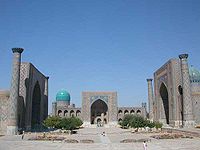
Samarkand, the Capital of the Timurid Empire
By bringing craftsmen from
different conquered lands to his capital in Samarqand
Toprak Qala Many desert castles can be found in the desert areas of ancient Khorezm, in Uzbekistan. One of the best known is Toprak Qala. In addition, palaces and fortresses in the region that are well known consists of the following: Ayaz Qala, Koy-Kirilgan Qala, Big Guldursun Qala, Pil Qala, Anka Qala, Kurgashin Qala and Djanbas Qala.
Trabzon (Trebizond) is a city on the Black Sea coast of north-eastern Turkey. Trabzon became a trading center located on the northern routes of the Silk Road, as well as a trade gateway to Iran in the southeast, Russia and the Caucasus to the northeast. Venetian and Genoese merchants paid visits to Trabzon during the medieval period and sold silk, linen and woolen fabric (with the Genoese having an important merchant colony within the city, which was similar to Galata in present-day Istanbul. During the Ottoman period, Trabzon, because of the importance of its port, became a focal point of trade to Iran, India and the Caucasus.
Trade Routes (See Routes)
Trading goods (items, merchandise, products, commodities) Various goods were bartered & traded along the Silk Road, while many forms of money were used over various periods. From ports, such as on the Red Sea, goods were transported overland along sea routes that linked the continents of Europe, Africa and Asia. Some well known items traded along these routes include: lapis lazuli, salt, metals, copper, iron, tin, gold, ivory, coral, gems, glass, porcelain, lacquerware, furs, horses, wool, slaves, animals, plants, grapes, ceramics, jade, bronze objects, amber, dyes, fragrances, spices, tea, rice, and luxury items such as silk. The exchange of goods also served as important channels and paths for cultural, political, commercial, and technological exchange between traders, merchants, pilgrims, rulers, soldiers, nomads, emissaries, envoys, missionaries, explorers, spies, bandits, and urban dwellers. The journeys of China's emissary, Zhang Qian, in the 2nd century BC brought the Han Dynasty (206 BC - 220AD) into political contact with numerous kingdoms in Central Asia, and opened up the East-West trade route known as the Silk Road. See Items of Trade
Train - The Orient Express The Orient Express was the name of a long-distance passenger train originally operated by the Compagnie Internationale des Wagons-Lits. Its route has changed many times, and several routes have in the past concurrently used the name. Although the original Orient Express was simply a normal international railway service, the name has become synonymous with Oriental mystery, intrigue and luxury travel. The two city names most intimately associated with the Orient Express are Paris and Istanbul, the original endpoints of the service. The route was made even more famous by the works of Agatha Christie and Graham Greene. Many passengers stayed at the legendary Pera Palace Hotel.
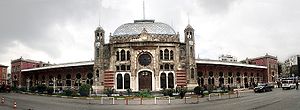
Transoxiana (Transoxania) is a name used for the portion of Central Asia corresponding approximately with modern-day Uzbekistan, Tajikistan and southwest Kazakhstan. Traditionally the land beyond the Oxus River, a traditional boundary of Iran with the outside world.
Travel Literature (travelogue) is travel writing of literary value. Travel literature typically records the experiences of an author touring a place for the pleasure of travel. An individual work is sometimes called a travelogue or itinerary. Early examples of travel literature include Pausanias' Description of Greece in the 2nd century CE, and the travelogues of Ibn Jubayr (1145–1214) and Ibn Batutta (1304–1377), both of whom recorded their travels across the known world in detail. The travel genre was a fairly common genre in medieval Arabic literature. Travel literature also became popular during the Song Dynasty (960–1279) of medieval China. The genre was called 'travel record literature' (youji wenxue), and was often written in narrative, prose, essay and diary style. Travel literature authors such as Fan Chengdu (1126–1193) and Xu Xiake (1587–1641) incorporated a wealth of geographical and topographical information into their writing, while the 'daytrip essay' Record of Stone Bell Mountain by the noted poet and statesman Su Shi (1037–1101) presented a philosophical and moral argument as its central purpose. In the 18th century, travel literature was commonly known as the book of travels, which mainly consisted of maritime diaries. In 18th century England, almost every famous writer worked in the travel literature form. Captain James Cook's diaries (1784) were the equivalent of today's best sellers. The best known travel literature about the Silk Road is by Marco Polo (1254 – 1324 or 1325), who was a Venetian traveler to China and the Mongol Empire. More...
Tsagaan Agui (or White Cave) Archaeologists have discovered 750,000-year-old stone tools dating from the Early Stone Age in a remote corner of Bayanhongor, Mongolia (also known as the Lower Palaeolithic Period of primitive man, or hominids). Other important sites include: the Gurvan Senkher Cave in southwest Mongolia's Hovd Aimag; Rashaan Khad / Rock in eastern Hentii Aimag; and in Moojoo in Uvs Aimag northwest Mongolia.
Tuan
Wu-ku-sun Chung Tuan (1220-1221) Chinese envoy, Wu-ku-sun Chung Tuan was sent to the
regions of Central Asia by the Kin Emperor to negotiate peace with Genghis Khan. He was accompanied by T'ing chen, and sent as ambassador of the
emperor. More...
Tulip Although tulips are associated with The Netherlands, commercial cultivation of the flower began in the Ottoman Empire. The centre of diversity of the genus is in the Pamir and Hindu Kush mountains and the steppes of Kazakhstan. The word tulip is ultimately derived from the Persian language dulband ("turban"). The use of tulips in art, and the "tulip mania" which rose from Asia and spread to Europe, is a fascinating story of how living organisms, such as silkworms, plants, and animals were transported across the Silk Routes.
Turcology (Turkology, or Turkic Studies) The study of Turkic-Turkish and/or Ottoman language, literature, and civilization. A person who studies in this field is called a Turcologist.
Turfan (See Turpan)
Turk According to Chinese historical records, the political existence of
the Turks in Asia commenced with the Xiongnu in the 3rd century B.C. The Xiongnu
were a confederation of
nomadic tribes
whose ethnic identity has been a subject of varied hypotheses (often referred to
as Turkic-Mongolic, or "the Huns"). The Xiongnu established a great empire under
the reign of Mete Khan. Defeating the Mongols and the Yuechis, they established
control over the western gates of China, as well as the trade routes.
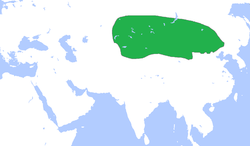
Chinese sources from the 3rd century BC document the creation of the Xiongnu
Empire under
Modu
Chanyu (who became supreme leader in 209 BC). The empire was described as
stretching beyond the borders of modern day
Mongolia.
In the 2nd century BC, the Xiongnu defeated and displaced the previously
dominant Yuezhi
and became the predominant power on the
steppes north
of China. They were active in southern
Siberia,
western
Manchuria, and the modern
Chinese
provinces of
Inner Mongolia,
Gansu, and
Xinjiang. Relations between early Chinese dynasties and the Xiongnu were
complex, with repeated periods of military conflict, alternating with exchanges
of tribute, trade, and marriage treaties.
After the collapse of the Asian Hun Empire, the Göktürk Empire was founded at
the eastern foot of the Altai Mountains. The Göktürks employed the word “Türk”
as an official state name for the first time in history. Known in Chinese
sources as
突厥
(Modern Chinese: Pinyin: Tūjué, Wade-Giles: T'u-chüeh).
More...
Turkey known as the crossroads between East and West, is also one of the great crossroads of civilizations. Turkey is also unique in that it is Asia’s foothold in Europe. The network of Silk Routes which began in China, extended across the continent of Asia, and then into southern Turkey and the Mediterranean. From this region trade routes continued onto European ports, or through the Near East down to North Africa. Maritime routes from Istanbul (Constantinople) and Turkey (Asia Minor) enabled trade to flourish between Asia and Europe. During the period of the Ottoman Empire these maritime routes became vital links, as Europeans established embassies in Constantinople, and trade activity decreased along the Central Asian land routes after the 1500's. More...
Turkey was, and still is, an important crossroads for both overland transport and maritime trade (the strategic Bosphorus Strait is located in Istanbul). These sea and land routes were closely linked throughout the ancient history of Anatolia, as well as during the Roman and Byzantine eras when the city of Istanbul was known as Constantinople. As a bridge between two continents, Turkey and Istanbul have served as a melting pot of cultures and religions, where major civilizations of the world have intermingled for 8,500 years -- the reason why Istanbul is referred to as "the crossroad of civilizations." One famous site of ancient civilization in Turkey is "Çatalhöyük," a settlement in southern Anatolia, which existed from c. 7500 BC to 5700 BC, and is the largest and best preserved Neolithic site found to date. The remains of other civilizations include:
Turkistan is a city in the southern region of Kazakhstan (Kazakh: Түркістан - Türkistan / formerly known as Turkestan - Russian: Туркестан). The city of Turkistan is located near the Syr Darya river. It has a population of 85,600 and is situated 160 km (100 miles) north-west of Shymkent on the Trans-Aral Railway between Kyzylorda to the north, and Tashkent to the south. Turkistan is one of Kazakhstan's historic cities with an archaeological record dating back to the 4th century. More...
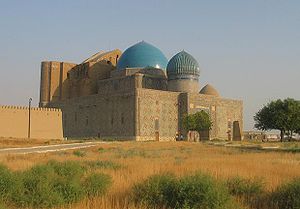
The Complex of Khodja Ahmed Yasawi in Turkistan
Xiyu (or "The Western Regions") was a historical name specified in Chinese chronicles between the 3rd century BC to 8th century AD that referred to the regions west of Jade Gate, most often Central Asia, or more specifically the eastern most portion of it (the Tarim Basin) -- also sometimes referred to as Turkistan. More generally, the Indian subcontinent and Middle East were also considered Western Regions. Because of its strategic location astride the Silk Road, the Western Regions have been historically significant since at least the 3rd century BC. It was the scene of conflict between the Han Dynasty and the Xiongnu until the middle of the 2nd century (during the Tang Dynastic see Turkic and Western Regions). The region became significant in later centuries as a cultural conductor between East Asia, the Indian subcontinent, the Islamic world and Europe. One of the most significant exports of the Western Regions was Buddhism, which was carried by traders and pilgrim monks to China. The Tang Dynasty monk Xuanzang crossed the region on his way to study in India, penning the classic "Great Tang Records of the Western Regions" upon his return to the Tang capital Chang'an. In the 18th century, the Qing Dynasty conquered part of this region and put it under military administration. In 1884, the region was established as a province under the name Xinjiang. More...
Note: "East Turkistan," or "East Turkestan" is a controversial term for the eastern part of the greater Turkestan region of Central Asia and is concurrent with present-day Xinjiang Uyghur Autonomous Region of China (the area is largely inhabited by Uyghurs, Han Chinese, Kazakhs and 16 other ethnic groups). The People's Republic of China disfavors the modern use of this term to refer to Xinjiang because it has been politicized by separatist groups. More...
Turpan (Turfan) near ancient Gaochang, Turpan is a city in Xinjiang, China, that was a major stop on the northern route of the Silk Road. During the Han Dynasty, Xiongnu nomads fought bitterly with the Chinese for control of the oasis town. Many of the historic treasures and ancient sites of the Silk Road are found in nearby areas, including some 200 ancient city sites, grotto temples, beacon sites, tombs and rock paintings. Many of the artifacts in the Xinjiang Museum were excavated in Turpan.
Turpan is one of the two centers of Uighur culture, and was the earliest
settlement of the Uighurs since the 9th century. Local religion, Muslim rites,
art and architecture are all steeped in Uighur history. Turpan was also once a
Buddhist center of the Silk Road. The famous monk Xuan Zang of Tang passed
through Turpan during his journey to the west (the pulpit where he preached is
still among the ruins of the ancient city of Gaochang).
The Bezelik Thousand Buddha Caves are
a complex of Buddhist cave grottos dating from the 5th to the 9th century, and
are considered enduring artistic treasures of the Uighurs.
Aydingkol Lake
in Turpan is 154 meters below sea level, second lowest lying lake in the world,
after the Dead Sea of Jordan. Turpan's highest annual temperature is nearly 50
degrees C, with an annual rainfall of only 16 mm. Turpan is the lowest
inland basin in the world, with most of its inhabitants living below sea level. The region,
known as one of the hottest areas of China, is
famous for its sweet grapes.
More...
Mosque in Turpan
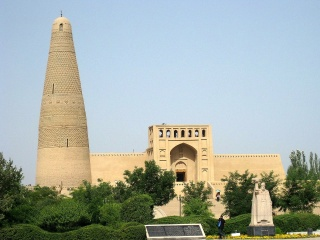
The Emin
Minaret and mosque is located along the Silk Road (near the ancient
Uyghur capital of
Gaochang).
The minaret is 44 meters (144 feet) high.
Turpan water system (Turfan Kariz Su Kanallari Muzesi) is located in the Turpan Depression, Xinjiang, China, and is a qanat system that has been listed as one of the three greatest water projects of ancient China together with the Dujiangyan Irrigation System, and the Grand Canal. A qanat (from Arabic قناة ) is a water management system used to provide a reliable supply of water to human settlements and for irrigation in hot, arid and semi-arid climates.
Tyre was the largest and most important city-state of Phoenicia, located on the Mediterranean coast (now present-day Lebanon). From about 2000 BC onwards through the Roman period, the Phoenician seaport of Tyre was famous in Roman times for its silk products and for a purple dye extracted from sea snails. "Tyrian purple" is a purple-red natural non-fading dye which was an item of luxury trade and greatly prized in antiquity. More...
Silk Routes.net | Ipek Yollari.net